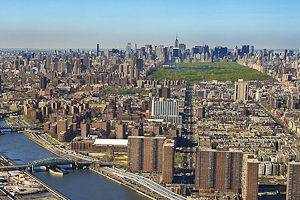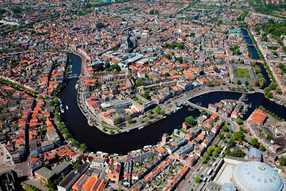About Harlem
 Panorama of the Harlem River, Harlem, Central Park and Midtown Manhattan in the background, seen from the Bronx in New York City
Panorama of the Harlem River, Harlem, Central Park and Midtown Manhattan in the background, seen from the Bronx in New York City
Harlem is a large neighborhood in the northern section of the New York City borough of Manhattan. Since the 1920s, Harlem has been known as a major African-American residential, cultural and business center. Originally a Dutch village, formally organized in 1658. it is named after the city of Haarlem in the Netherlands. Harlem's history has been defined by a series of economic boom-and-bust cycles, with significant population shifts accompanying each cycle.
African-American residents began to arrive in large numbers in 1905 as part of the Great Migration. In the 1920s and 1930s, Central and West Harlem were the focus of the "Harlem Renaissance", an outpouring of artistic work without precedent in the American black community. However, with job losses in the time of the Great Depression and the deindustrialization of New York City after World War II, rates of crime and poverty increased significantly. Harlem's African-American population peaked in the 1950s. In the second half of the 20th century, Harlem became a major hub of African-American businesses. In 2008, the United States Census found that for the first time since the 1930s, less than half of residents were black, comprising only 40% of the population. Since New York City's revival in the late 20th century, long-time residents of Harlem have been experiencing the effects of gentrification and new wealth.
Source: Wikepedia
Read here a blog how to live like a local in Harlem
African-American residents began to arrive in large numbers in 1905 as part of the Great Migration. In the 1920s and 1930s, Central and West Harlem were the focus of the "Harlem Renaissance", an outpouring of artistic work without precedent in the American black community. However, with job losses in the time of the Great Depression and the deindustrialization of New York City after World War II, rates of crime and poverty increased significantly. Harlem's African-American population peaked in the 1950s. In the second half of the 20th century, Harlem became a major hub of African-American businesses. In 2008, the United States Census found that for the first time since the 1930s, less than half of residents were black, comprising only 40% of the population. Since New York City's revival in the late 20th century, long-time residents of Harlem have been experiencing the effects of gentrification and new wealth.
Source: Wikepedia
Read here a blog how to live like a local in Harlem
About Haarlem
 Overview of Haarlem
Overview of Haarlem
Haarlem is a city and municipality in the Netherlands. It is the capital of the province of North Holland and is situated at the northern edge of the Randstad, one of the most populated metropolitan areas in Europe. Haarlem had a population of 155,758 in 2014. It is a 15-minute train ride from Amsterdam, and many residents commute to the country's capital for work.
Haarlem was granted city status or stadsrechten in 1245, although the first city walls were not built until 1270. The modern city encompasses the former municipality of Schoten as well as parts that previously belonged to Bloemendaal and Heemstede. Apart from the city, the municipality of Haarlem also includes the western part of the village of Spaarndam. Newer sections of Spaarndam lie within the neighbouring municipality of Haarlemmerliede en Spaarnwoude.
Source: Wikepedia
Haarlem was granted city status or stadsrechten in 1245, although the first city walls were not built until 1270. The modern city encompasses the former municipality of Schoten as well as parts that previously belonged to Bloemendaal and Heemstede. Apart from the city, the municipality of Haarlem also includes the western part of the village of Spaarndam. Newer sections of Spaarndam lie within the neighbouring municipality of Haarlemmerliede en Spaarnwoude.
Source: Wikepedia